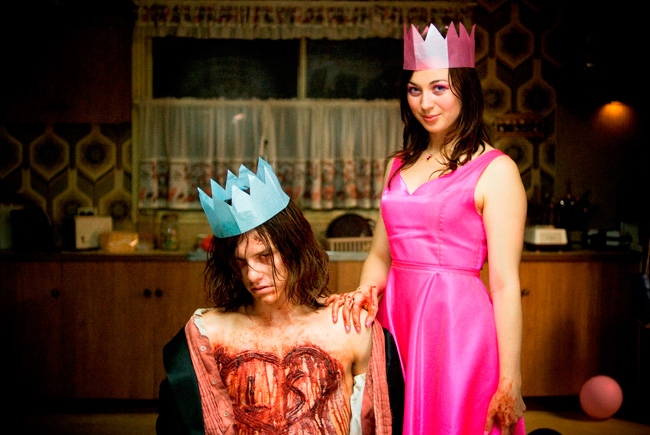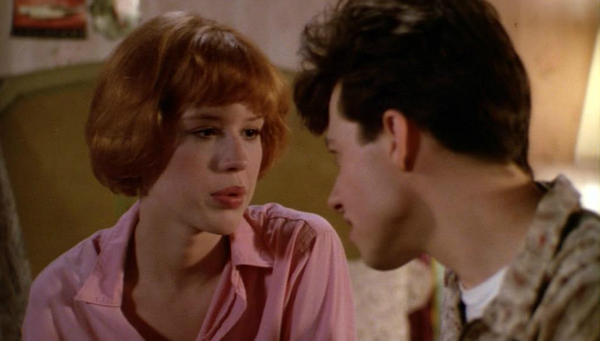Like most horror films, prom horror is about teenage girls and what they chose to do with their bodies. As a culture, it’s a topic we find truly terrifying.
We’re taught to think of prom night is an important moment, as a signifier for burgeoning, barely contained sexuality and transformation. It’s the night good girls become bad girls, shy girls reveal their hidden confidence and ugly girls shed their glasses or comb their hair and look almost beautiful, imperceptible from their peers. Prom is also held up as a sort of pre-wedding, “the night” where a couple must have special sex in a fancy hotel room with roses on the bed and special lingerie, and the night when “good girls” decide to lose their virginity. It’s as close as we have to a coming of age ceremony, like a young woman’s first menstruation or first sexual encounter, prom night is a milestone where she can be said to change from girl to woman. In the slasher Prom Night, it’s no coincidence that the high-schoolers face the killer’s vengeance on this particular night, when they enter adulthood and are finally old enough to face the consequences of their actions.

In the three Carrie films, Carrie White’s first period comes just ahead of her senior prom, and along with it, the full bloom of her telekinetic powers. Her prom also awakens her repressed sexuality, as Carrie admires her body in her prom dress, displaying the tops of her breasts, which her mother has taught her are shameful “dirty pillows” she must always cover, for the first time. In the 2013 remake, Carrie’s delight in her power is also tied to her sexuality as she makes slightly orgasmic facial expressions when using them.
Part of the extreme resentment, Chris, Carrie’s chief tormenter, shows toward her, can be seen as stemming from jealousy of Carrie’s excitement about prom and with it, sex. For Carrie, these things come to mean rebellion and at least initially, in preparing for prom, are empowering for her. Meanwhile, Chris, in the original 1976 film at least, appears to treat sex as a chore. What appears to turn her on, is her hatred of Carrie; she licks her lips before releasing the bucket of blood and talks about Carrie while fooling around with her boyfriend.
Besides the whole telekinetic powers thing, the part of Carrie that has always seemed unrealistic to me is that Carrie, a girl who has been tormented and abused by her classmates her whole life, even goes to prom. It’s always been slightly unbelievable that she would accept Tommy’s invitation without insisting it had to be the set up for a trick. But maybe she believes in what pop culture has always told us about prom night, that it has transformational powers, a strange magic that could make one the most popular boys in school ask out an outcast and end up really liking her upon getting to know her, that all her classmates could see the change in her and honestly vote her prom queen. After all, visually she does transform. She’s beautiful in her new dress, everyone is shown admiring her and as she gains control over her powers, she has become much more confident. With the final show of her telekinetic revenge from the stage, abused Carrie transforms into something monstrous, but understandable. On prom night, she gains her autonomy and reveals and revels in her adulthood.

Likewise, in The Loved Ones, a 2009 Australian film, a shy, quiet outcast (Robin McLeavy) reveals her true self on prom night. In the beginning of the film, she asks her crush, Brent (Xavier Samuel), to the prom, and is rejected. At school, she appears awkward and weird, and is never really an option for Brent, who has a conventionally attractive, sexually confident girlfriend. Horror arrives when Brent is kidnapped by Lola and her father, and learns that they have been regularly kidnapping teenage boys in search of “the one” for her. Lola’s father has set up a prom night for her in their own house, including a spinning disco ball, showers of glitter, and her favorite song on the stereo, and within it, she is powerful and frightening, a monstrous creature who tortures Brent and believes that on prom night, this may make him love her.
Horror films can also play on our culture’s fear of sex as an act that can change a good girl into a bad girl, by showing a virgin literally turn into a insatiable succubus after her first time. Prom Night 2: Hello Mary Lou follows Vicki (Wendy Lyon), a virginal sweetheart nominated from Prom Queen at her high school, who becomes possessed by the spirit of dead 1957 Prom Queen, Mary Lou (Lisa Schrage). Like Carrie, Vicki’s sexuality is repressed by her religious mother, who refuses to buy her a new dress for prom, as she finds them inappropriately sexual.

Though it’s a horror film and she goes on a murderous rampage, we are meant to understand Mary Lou is a “bad girl” when she is shown confessing her sexual exploits to a priest and refusing to repent for them. Instead, she leaves her phone number in the confessional, and writes, “For a good time, call Mary Lou.”
Using Vicki’s body, she lures students to her death by promising sex and in gratuitous one scene, chases a rival through the locker room, completely nude and attempts to seduce her. All of Mary Lou’s villainy is tinged by her equally villainous sexuality, including one scene where she, within Vicki’s body, gives Vicki’s father a passionate kiss.

The rituals of prom night–getting dressing and applying makeup in front of the mirror, posing for pictures, crowning of the prom queen, and the first slow dance–are familiar enough as cultural markers that horror movies can illicit a strong response by perverting them. Prom horror typically lulls viewers into complacency before everything turns dark, by playing some of these traditional markers straight and suggesting the film is merely a happy story of prom night as wish fulfillment. Lola and Brent’s story is intercut with scenes of the more realistic, wish-fulfillment prom night experienced by his best friend. Similarly, the 2008 remake of Prom Night led up to the big night with scenes of the young characters excitedly getting their hair done, trying on their dresses and sticking their heads out of the limo’s sunroof, all set to bright poppy music. In The Loved Ones, Lola and her father force their captives though a series of twisted prom night rituals, where they eat dinner together, dance under the disco ball, pose from pictures, and are crowned prom king and queen, only through all this, Brent’s feet are nailed to the floor and the prom photos display him more like a trophy than a date, with Lola’s initials carved across his chest. Early on, Lola’s moment of transformation is perverted, as while she changes into her perfect prom dress, she tells her father to stay and he watches, lustful from the door.

2008’s Otis is a similar type of captive prom date film. In it, a pedophilic serial killer (Bostin Christopher) kidnaps a teenage girl, Riley (Ashley Johnson) and forces her to play the role of the girl who rejected him in high school and help him reenact the prom he dreamed of. Through the film, he drags her though a prom tableau set up in his basement: a girly bedroom where he calls to ask her out, a car where he forces her to pleasure him and finally a dance floor where he holds the actual prom. Otis is influenced by an idea of what a classic, even cookie cutter prom should be. In his prom-fantasy, he dates a blonde cheerleader, drives a classic car and is even named prom king.
It’s interesting that pink dresses are so common in these films. Carrie’s homemade prom dress is pale pink, all the better to show off the pig blood stains. Mary Lou’s dress in the 50s is pink, as is the cookie cutter dress Otis buys for Riley. In The Loved Ones, pink is Lola’s power color and her room is full of it. Both the paper crown and the prom dress her father buys her are bright, stinging pink, that nearly glows. Pink is a traditionally girly color, one that signifies childhood and innocence, and it’s no coincidence that the chief wish fulfillment prom film is called Pretty in Pink.

As a signifier of adulthood, prom night also suggests a dismissal of childish things, shortly after, there will be graduation, maybe college, and the graduating class will move out of their childhood rooms. In a disturbing scene in Hello Mary Lou, a possessed Vicki, all dolled up for prom, sits atop the pastel colored rocking horse in her bedroom, as it comes alive, with a twisted, demonic face, red eyes and an outstretched tongue. Likewise, Lola perverts her dolls and stuffed animals by setting them in sexual positions, showing the uncomfortable melding of childhood and adulthood in her mind.

That these girls chose pink dress also suggests their purity is slightly tarnished or that their dresses are white that has been diluted by blood. Moreover, it suggests a junior or training wedding.
Like a wedding, prom night is characterized by patriarchal rituals that make a father responsible for his daughter’s sexuality. In pop culture, fathers joke about having to lock up their daughter on prom night and worry about them getting pregnant or secretly giving birth in the bathroom. It’s the first time they are asked to see their daughters as sexual beings and trust them to be grown-ups going out into the world.
In typical prom rituals, a father meets his daughter’s date when he comes to pick her up and in shaking his hand, symbolically hands her over to him. Otis goes as far as to call Riley’s father, once he already has her held hostage, to ask for his permission to take her out. In The Loved Ones, Lola’s incestuous desire for her father helps paint her as monstrous. As they dance together, she tells him she can’t be satisfied with any of the teenage boys they have kidnapped because he is the only one for her.
Moreover, though the characters in these prom horror stories arrive with a date, they tend to leave alone, as if abandoned after sex, for a “walk of shame” the morning after. In Otis, Riley escapes, still in her prom dress, while The Loved Ones ends with a morning after chase sequence through the outback between Lola and Brent and his girlfriend. In this last fight, Lola appears to lose both her strength and confidence, as if depleted by her prom night. Likewise, after leaving the school gym, Carrie enacts more brutal wrath on her long walk home. In all versions, she walks alone through the town, as if possessed, until she arrives home for her final confrontation with her mother, her final symbolic shift into adulthood.

A culture’s horror stories have always reflected what they finds terrifying, by exaggerating it and moving it into allegorical contexts. To some extent, this has always included female sexuality, from the fear of liberated women in Dracula to the virgin/whore dichotomy of the slasher film, and probably always will. Prom continues to resonate as, displayed by last year’s Carrie remake. Although the film has its problems, the basic storyline continues to be as relevant today as it was in the 70s. Prom Horror will likely continue to crop up every few years, shaded by whatever trend in their teenagers’ lives are frightening adults at the time, like the use of cyber bullying in Carrie.
See also at Bitch Flicks: Prom and Female Sexual Desire in Pretty in Pink and The Loved Ones
_______________________________________________________________________
Elizabeth Kiy is a Canadian writer and journalist living in Toronto, Ontario.










